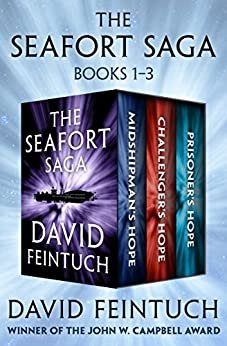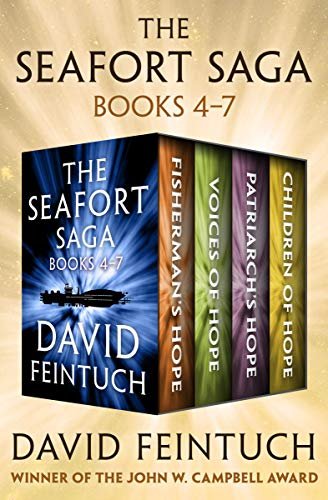The Long View: The Seafort Saga
I read David Feintuch's Seafort Saga because John reviewed the first five books in the series in 1996. I stopped after the fourth, even though two more books had been released since the time John reviewed them. I actually did this on John's advice, since Feintuch had invented a kind of pidgin for the tribal denizens of New York City, that ended up being painful in print.
I think this book series is worth a read, although it is not the kind of book I am going to return to again and again. Fun, but not a true classic. In my own reviews, I seconded John's [and Steve Sailer's] notion that science fiction often tells you far more about the time period in which it was written.


The Seafort Saga
by David Feintuch
Aspect (Warner Books)
Midshipman’s Hope
1994, $5.50, pp. 391
ISBN: 0-446-60096-2
Challenger’s Hope
1995, $5.50, pp. 407
ISBN: 0-446-60097-0
Prisoner’s Hope
1995, $5.50, pp. 506
ISBN: 0-446-60098-9
Fisherman’s Hope
1996, $5.99, pp. 482
ISBN: 0-446-60099-7
Voices of Hope
1996, $5.99, pp. 527
ISBN: 0-466-60333-3
Who says they don’t write space-opera like they used to? I do. The Seafort Saga is a good example of how science fiction bears the imprint of the period in which it was written.
In some ways, this series might have been written in the early 1950s. Certainly the author makes assumptions that science fiction writers have been making for fifty years. Thus, a way has been found to travel faster than light and the United Nations has become a world government. More generally, certain aspects of life in the future closely resemble life in the author’s favorite area of the past, which in this case seems to be Queen Victoria’s navy.
The author puts these familiar devices to good use. These five novels are about the career of an officer of the UN Space Navy. They are set, for the most part, in the early 23rd century. The protagonist defeats several alien invasions. There are lots of unsatisfactory people and things in the universe that need to be incinerated with lasers, and the series disposes of a large fraction of them. Indeed, had the series actually been written in the 1950s, it would have been considered remarkable for its vivid characterization and psychological insight.
On the other hand, there are many things about the Seafort Saga that mark it as a work of the 1990s. Some of these are scientific fashions, such as the notion that animal life in general and intelligent life in particular are so improbable that the human race is unique in the universe. (The alien menace, as we will see, leaves something to be desired.) The physics of faster-than-light travel may owe something to the theories of the cult-physicist, David Bohm. Aside from science, the series reflects the period of its composition in such matters as the relentlessly coed military and the fact that socialism is absent from the conceptual universe of the characters. Indeed, the most interesting difference from the science fiction of fifty years earlier is the change in the cultural trajectory of the future history the author imagines. Mid-century science fiction usually assumed that the alternative to secular modernity was barbarism. The world of the Seafort Saga, in contrast, really is postmodern in a way that will remind readers of Oswald Spengler’s forecast of the “Second Religiousness.”
The story is told mostly in the first person by the protagonist, Nicholas Ewing Seafort. His story begins with the words, “October 12, in the Year of the Lord 2194,” and he means every one of them. In this he is not unusual. The United Nations that governs the human race is a theocracy which supports and is supported by the Reunification Church. I kept expecting the protagonist to lose his faith, or at least to come into conflict with a larger secular society, but to my surprise these things did not happen. The UN is a democratic theocracy, in that its legislature and chief executive are popularly elected, albeit by a somewhat restricted franchise. Nevertheless, its legitimacy is based on a claim of divine right, and treason is prosecuted as blasphemy. One can view the author’s Reunification Church it as another Victorian parallel, a tolerant but unavoidable established church that somehow manages to incorporate all the major historical faiths as “synods” under its broad roof. Still, the universal creed is ecumenicism with teeth.
The world of the 23rd century is variously draconian. There is a great deal of hanging and corporal punishment, and imprisonment is devoid of the concept of rehabilitation. Incorrigible members of the urban underclass are forcibly transported to colony planets as unskilled labor. Despite these dark features, this is not a story about a totalitarian future. Rather, it is a time of ordinary unhappiness. The brutality of the law is the result of the horror with which respectable people look back at what are called “the Rebellious Centuries,” a period that seems to encompass western modernity from the Enlightenment to the early 21st century.
Actually, as we see, the return to moral rigor has only limited success. The problem with the government, despite its moral hectoring, is really that it is too lax rather than too strict (a characterization which will perhaps also remind readers of the 1990s, at least in the United States). Universal education has been declared to be impossible, and so the world’s major cities have been almost abandoned to tribalized savages. The UN Army is remarkably corrupt and the Space Navy runs on nepotism. Nevertheless, this state of things is regarded as an improvement, particularly over the 20th century.
The first four books have the same basic plot: the young officer Nicholas Seafort assumes authority in an emergency and takes some ethically ambiguous action that makes him a hero instead of getting him hanged. He starts in the first book as a teenage midshipman taking command of an interstellar transport after all the other line officers have been killed in a shuttle accident. (The wise old engineering officer survives, but cannot take command because he does not have that kind of commission. Inevitably, he is a Scotsman.) In the second book Seafort saves another transport, though one he is supposed to be in charge of. In the third book, he saves a colony planet. In the fourth, he saves the solar system. The fifth book is more modest, since it is largely dedicated to the effort of the middle-aged Seafort’s young son to save barbarian Manhattan Island.
What Seafort mostly saves people from is a species called the Fish. The Fish look like goldfish, except that they have no eyes or mouth, and they are the size of battleships. They live in space, though they can descend to planetary surfaces through no obvious mechanism, and they can travel at superluminal speeds when it suits them. They attack human beings and human artifacts, mostly by dissolving them on contact, though they also capture asteroids and drop them on large targets, such as cities. It is never made clear whether these things are intelligent. They manifest a certain tactical sense, but they are finally defeated by a simple technical gimmick.
As space monsters go, the Fish are in fact rather perfunctory. Their function in the plot is simply to put stress on the UN Space Navy, which by the time of the first book has gone to seed in rather the way that the British Navy did between the Battle of Trafalgar and the reforms of the last quarter of the 19th century. Because of his exploits against the Fish, Seafort is given the nickname “the Fisherman.” This may perhaps be an obscure allusion to Sir John Fisher, who was in large part responsible for those late-Victorian reforms. Be that as it may, the Space Navy in the late 22nd century has many of the same incentives to institutional rust as did Victoria’s navy. Until the Fish appear, it too has no real enemies, but it does have a glorious tradition and a limited budget. In both cases, gunnery practice is a largely ceremonial affair. Tactics have either been forgotten or bear no relationship to current technology. In the Seafort books, the Navy justified itself largely as a merchant marine, since the UN forbade the operation of private transport in space. It was therefore understandable that braid-encrusted admirals, when confronted with acid-spitting interstellar goldfish, would give the order made familiar by the character of King Arthur in “Monty Python and the Holy Grail”: “Run away! Run away!”
The book that stands best on its own is perhaps the fourth one, “Fisherman’s Hope.” The story there concerns Seafort’s tenure as commandant of the Space Academy. He had graduated only a few years before, but received the appointment as the only job he would take after his last adventure which, again, required that he take action troubling to his pious conscience. His stint at the academy leaves him with more than usual to be troubled about, since by the end of it he has fed a large fraction of the student body to the Fish in order to lure those clichés to their destruction. Before that, however, he makes numerous dramatic reforms, and we are treated to a better-than-average boarding school story from the principal’s point of view. Another advantage to the book is that it quotes from the earlier volumes so much that you miss little of the logic of the series if you don’t read them.
The fifth book is something of a disappointment. This is because it concentrates almost exclusively on the “transpops,” the urban underclass, who had played background roles in the earlier volumes. The action deals with the adventures of Seafort’s precocious son among the transpops of Manhattan, just as these detrimentals rise in revolt because their water supply is cut off. Part of the problem with the transpops is purely conceptual. Is really likely that a neo-Victorian world government would let the earth’s great cities go to seed? That is just the opposite of what the real Victorians did; they were urban reformers from first to last. In the series, the UN headquarters is still located on the East River shore of Manhattan Island. The headquarters is of course a fortress, almost totally isolated from the surrounding city. Still, it somehow seems out of character for even the most isolated government to tolerate cannibalism in the darkened subway tunnels a few block away.
The major trouble with the transpops, however, is artistic. The author has devised an urban dialect for them, compounded of Black English and Brooklynese. It is unlovely and hard to read, and it goes on for pages and pages. Furthermore, the transpops themselves are dirty and violent. They are not fun to read about even in the most lucid prose. They were, no doubt, created to highlight the inflexible puritanism of the upper classes. However, halfway through this book I, too, would have been willing to turn off their water. In his listless depiction of a derelict New York City, the author seems to acting less as a fantasist trying to imagine the future than as yet another disgruntled tourist.
Despite these reservations, the whole series make wonderful beach books. There is lots of action, much of it implausible but all of it well paced. Seafort himself, groaning under the accumulating weight of his sins, is engaging if not invariably likable. Some people might find him genuinely edifying. Reading books like these is unlikely to tell you very much about the future. The future, however, might usefully have recourse to them to find out something about the time in which they were written.
Copyright © 1996 by John J. Reilly
Comments ()